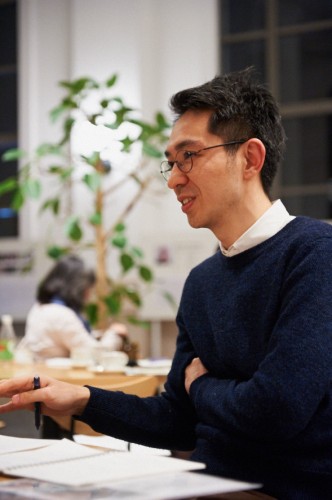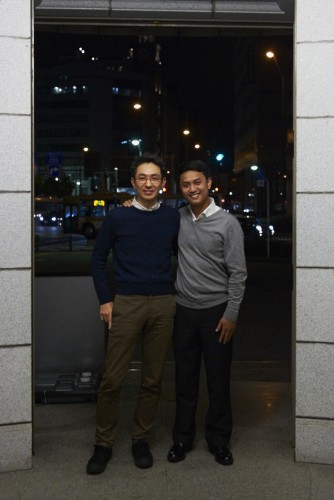The Synergy Gained by Connecting Art and Economy
―Could you elaborate a bit more on the idea of social impact?
Prim: First, art can give people an identity, which creates the basis of society. I see the arts as a way of life. As in any other projects, I explore how to make it possible to have an income that is stable enough to support one's family. Also, as I said before, I think the arts teach us how to think about the future; they involve life skills that cannot be taught.
I think my ideas are slightly different than people who are experienced in the arts and nonprofit work; I'm from the world of business. I don't want to have any project be a one-off event, so it's important for me to think about how to make it sustainable.
For example, Cambodian Living Arts is a nonprofit organization, so fundraising is necessary to maintain our activities. To have a more stable income, we opened a performance space that targets tourists in Phnom Penh. I call it a "creative industry" program. We reinvest the income into our projects. The balance between artistic and commercial visions is important, so we created a space for promoting the arts, as well as a space for linking the arts and commerce.

Photo: Jouji Suzuki
―What do you think is needed to link the arts and economy?
Prim: Creating an audience and marketing to it. Generally, artists and nonprofit organizations don't know how to make money through their art. Sometimes, even artists who have wonderful ideas don't know how to explain their work to the public. In other words, they cannot put their work into the market, and present it as something valuable.
Arts managers play an important role because they understand the needs of both the artists and the audience; that is the only way to make culture and the arts sustainable.
―You mentioned tourism. What about the relationship between tourism and art?
Prim: Tourism is a big market across the world, and every country pays attention to it. However, you have to be careful about the relationship between tourism and art. For example, tourists who visit New York go to famous tourist spots and see The Lion King or The Phantom of the Opera on Broadway. They don't go to alternative spaces where the most innovative works are presented. Innovative creations are made in the fringes, and TPAM is one of them. I think it is important to maintain balance of the whole.
It is not difficult to create marketing that targets tourists; all you have to do is shift it to entertainment. However, art involves more intellectual elements than entertainment, so to promote art, it is necessary to have an interest in the market and understand it.
Issues around the First Cultural Policy of Cambodia
―I heard that the first cultural policy of Cambodia was recently pronounced. What was it about?
Prim: It was very general. For example, the government bases its advocacy of creativity on tradition, but I advocate the importance of contemporary creativity. I have claimed that creativity has been promoted in the contemporary context in foreign countries, but the government didn't understand me.
In spite of that, I think the fact that they made a cultural policy is an important step. The existence of a cultural policy is very important, and it should be one of the four pillars of the government (i.e., education, economy, environmental sustainability, and culture).
―Then what kind of issues do you think Cambodian people have been experiencing?
Prim: We are in the middle of a drastic change. Young people are going to lead the times, but there are a lot of political issues. I have found some hope in the previous election of the National Assembly.
The current Prime Minister has been there for more than 20 years, but young people think they need a new leadership model. The leadership of the country was traditional—even before Sihanouk was the Head of State. However, the current Prime Minister (Hun Sen) started reform. Young people want reform too. The reform has been making changes, but it is occurring much faster than I expected.
Facebook is one of the most popular media platforms. Everyone can freely say what they want. The government doesn't control Facebook. The Prime Minister uses Facebook every day.

Photo: Jouji Suzuki
―What do you think is the biggest issue that Cambodia will face in the future?
Prim: Personnel capacity. In Cambodia, there are many young people at the bottom of the population pyramid. 70% of the population is younger than 30, and more than 50% is under 21. There are not many old people, but the population between the young and the old is very small.
Therefore, it is expected that there will be a shortage of national leaders. So I want to invest in human resources. In the rapid change of the country, I think we need leaders and managers who realize innovative ideas.
A Necessary Investment in Future Generations
―What do you specifically mean by investing in human resources?
Prim: Investment in education. I always say that we cannot change the world in a few years. The World Bank thinks that they can change the world in five years, but I think we should have a perspective that includes impacts on future generations.
I have been creating a five-year strategy (between 2020 and 2025). Art plays the central social role, as an investment in future generations. We started a pilot project with the Ministry of Education, Youth, and Sport—for bringing art into school. I want the Ministry to take it over after the project ends in 2025, and I have been working on a model for that.
―Outreach has also been active in the field of education in Japan. What are the characteristics of your project?
Prim: Tradition is as important as contemporary creation—in any culture in any country. Tradition embraces the roots of the country's culture. The balance between tradition and contemporaneity is indispensable, but because of the loss of tradition that has to be passed on from one generation to the next generation, there have been more and more young people who don't have an idea about the roots of tradition and culture. It is unstoppable that they get interested in contemporary and foreign culture, but I think we should offer opportunities for understanding the basis of tradition to build the pillars of society.
―Last but not least, could you clarify your vision of the future?
Prim: In addition to an investment in education, I look forward to having young leaders work in the cultural sector. I also have a dream of building a beautiful arts center in Phnom Penh. In addition, I have been thinking about founding a fund that will support artists' creations. I want to make the environment better, so that young generations can be active after I retire.

Photo: Jouji Suzuki
(February 13, 2016 at Yokohama Creative City Center)
Interview and text: Taro Inamura
Born in 1976, Inamura was inspired by an exhibition, "Of the Human Condition: Hope and Despair at the End of the Century." Then he became interested in the art world. While studying art in college, he organized music events at clubs in Tokyo.
After engaging in contemporary art exhibitions at private cultural facilities, he moved to the U.K. There, he studied the transition after the Tony Blair administration and evaluated its cultural policy and the management of its creative industry. He is currently a program officer at Saison Foundation and a researcher at NLI Research Institute.






